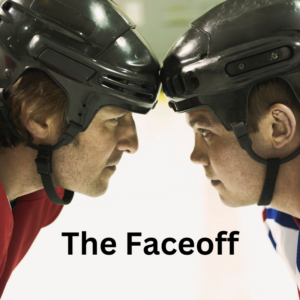Watching hockey for beginners is so much more enjoyable if you know the basics of the game. Welcome to Ice Hockey 101. Let’s explore some of the most important rules in ice hockey and how they shape the game we love.

Ice hockey is more than just a sport; it’s a symphony of speed, skill, and strategy, played out on a frozen canvas. With its fast-paced action and bone-jarring collisions, hockey captivates audiences worldwide. But beneath the surface of this thrilling game lies a set of rules that govern every pass, shot, and check.
Offsides:
Perhaps the most fundamental rule in hockey, offsides prevents players from cherry-picking near the opponent’s goal. To maintain the flow of the game, attacking players must not precede the puck into the offensive zone. This rule fosters teamwork and strategic puck movement, as players must coordinate their entries into the attacking zone.
Icing:
Icing occurs when a player shoots the puck from behind the center line and it crosses the opponent’s goal line untouched. This rule prevents teams from simply clearing the puck to relieve pressure and encourages controlled breakout plays. Icing results in a faceoff in the offending team’s defensive zone, penalizing careless puck disposal.
Penalties:
From slashing to tripping, penalties serve as the game’s disciplinary mechanism. Players who commit infractions are sent to the penalty box, temporarily reducing their team’s strength. Penalties can dramatically shift momentum and provide power play opportunities for the opposing team, making discipline a crucial aspect of hockey strategy.
Faceoffs:

Faceoffs are the starting point for many hockey sequences, occurring at various points on the ice after stoppages in play. These battles for possession demand quick reflexes and precise technique, as players jostle for control of the puck. Faceoffs play a pivotal role in dictating possession and can influence the outcome of a game.
Body Checking:
A hallmark of physicality in hockey, body checking is the art of using one’s body to separate an opponent from the puck. However, strict rules govern the legality of checks, emphasizing player safety above all else. Body checking adds an element of intimidation and strategy to the game, requiring players to balance aggression with control.
Goaltender Interference:
Protecting the goaltender is paramount in hockey, as they serve as the last line of defense against opposing attacks. Interfering with the goaltender’s ability to make saves, whether through contact or obstructing their vision, results in penalties and nullified goals. This rule ensures fair play and maintains the integrity of scoring opportunities
High Sticking:
High sticking occurs when a player’s stick makes contact with an opponent above the shoulders, posing a significant risk of injury. Whether accidental or intentional, high sticking carries severe penalties and underscores the importance of stick control. Players must exercise caution to avoid dangerous plays that can result in serious consequences.
Offensive Zone Penalties:
To prevent teams from stalling in the offensive zone, penalties committed in this area result in a unique consequence. Instead of a faceoff in the defending team’s zone, play resumes with a faceoff in the neutral zone. This rule incentivizes disciplined play and discourages offensive players from committing careless infractions.
Overtime Rules:
In the event of a tie at the end of regulation, overtime provides an exhilarating conclusion to hockey games. Overtime periods feature fewer players on the ice, intensifying scoring opportunities and sudden-death drama. Overtime rules vary between leagues, but the objective remains the same: score the game-winning goal and secure victory for your team
Video Review:
In the modern era of hockey, video review has become an indispensable tool for ensuring accurate officiating. Whether confirming goals, assessing potential infractions, or determining the validity of challenges, video review enhances the game’s fairness and transparency. While controversies may still arise, video review helps uphold the integrity of the sport.
Conclusion: These basic rules form the backbone for the enjoyment of ice hockey, shaping every aspect of gameplay from strategy to sportsmanship. As players navigate the fast-paced action on the ice, adherence to these principles ensures a level playing field and a thrilling spectacle for fans around the world. So, whether you’re a seasoned veteran or a newcomer to the sport, remember these commandments of hockey as you embark on your journey to master the ice.
Thanks for your time. Please leave comments and suggestions below.




